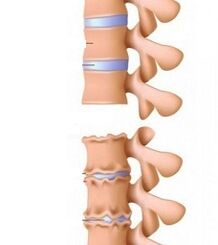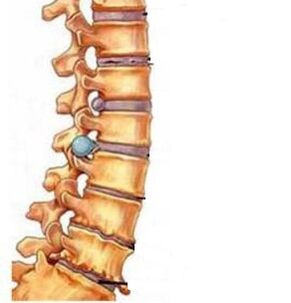
Osteochondrosis of the cervical region is a disease associated with impaired metabolic processes, namely the accumulation of salts in the blood and lymph, which leads to pathological transformation of the structure of the intervertebral discs, vertebrae and joints between the vertebrae.The loss of cartilage tissue of elasticity contributes to the displacement of vertebrae, pinches of arteries and other dystrophic changes.
Due to the deformity of the joints, the height of the intervertebral discs decreases.It should be noted that in the cervical region the vertebrae are located closer to each other than in other parts of the spine and therefore the discs are in a health condition.
Osteophytes (bone growths) are formed on the side of the vertebrae, which irritate the muscles, causing their tension.Osteophytes also squeeze the roots of the spinal nerve, spinal artery and small blood vessels from which brain cells do not receive enough blood.The brain breaks down and dies.
By the frequency of osteochondrosis on the door in the second place after the lumbar cross.The first signs of the disease can occur in school age, after 25 years in one form or another, this disease is observed in almost all.In women aged 45-65, additional symptoms occur - tingling in the area of the hands during sleep against the background of pain and numbness.
The causes of the development of osteochondrosis of the neck
Hypodynamia - a sedentary, sedentary lifestyle, leads mainly to cervical osteochondrosis.As a rule, they suffer from people whose work involves a long stay in one position: work on the computer, office workers, drivers, etc.Osteochondrosis should be expected if a person has an incorrect posture or holds the body abnormal for a long time, for example, holds a mobile phone or phone with a shoulder.

Improper computer stand leads to osteochondrosis of the uterus!
Excessive back and neck stress causes excessive physical activity unusual for the body, such as lifting weights.The same effect is obtained by improper exercise.
The degeneration and dystrophy of the cervical region are due to constant nervous tension and stress, prolonged or temporary hypothermia of the body, unbalanced, scarce nutrition, infections.
The increased risk group belongs to people with hereditary predisposition to osteochondrosis, with defects in the development of the spine, with a traumatic spine or vice versa.The danger is chronic diseases of the musculoskeletal system (rheumatism, scoliosis, systemic lupus erythematosus).The disease is preferred by hormonal imbalance, overweight, flat legs, progressive discos.
The main symptoms of cervical osteochondrosis and the factors causing them
The main symptom of osteochondrosis is pain in the back segment of the neck.If the nerve roots are affected, the pain extends on the shoulders, the forearms.With the spasm of muscles and impaired blood circulation, there is pain in the ears, eyes, teeth, forehead.It can be succumbed to shoulder blades, chest, gall bladder, lower back.The painful sensations increase even with minimal loads, long sitting, slopes or turns of the head.The pain mainly manifests itself after sleep and disappears if you develop muscles.Frequent departments occur - acute pain, combined with muscle hardening and movement difficulties.

There is numbness of the arms and legs, burning and tingling.The damaged roots with the nerves of the engine weaken the strength of the muscles of the limbs.Blood pressure can rise, take the heart.
The cervix department with complex intervertebral discs, osteophytes of the vertebrae and affected intervertebral joints creak and crunch if you sharply throw it or turn your head.
The tense arteries and poor blood supply to the back of the brain and brain leads to neurotic disorders, which manifests in the form of irritability, anxiety, mood variability, resentment and insomnia.There are outbreaks of anger, nervous anorexia, fear, longing.
For the same reason, the tongue and tip of the fingers are numb, voice wheezing, hearing and vision decrease, rustle in the ears, darkens in the eyes, a seizure occurs.Almost always, especially in women, there is a continuous headache, even more severe if you turn your neck sharply.
The affected vestibular apparatus leads to disorientation in space, impaired coordination, dizziness and nausea and vomiting associated with these phenomena.
Stages of development of osteochondrosis of the neck
Cervical osteochondrosis develops stadium, each of the stages has its own clinical picture.
In the first stage (preclinically) the muscles are slightly tense, the pain is weak when the head rotates or tilts, it can increase.The rapid fatigue of the spinal and lumbar muscle is characteristic.At this stage, the disease is treated without medication.

The second stage occurs with a decrease in the height of the intervertebral disc and the pinching of the nerve endings.In addition to the neck, shoulder and arm hurt.Rapid fatigue, headache, scattering occurs, work is difficult and productivity is reduced.
The third stage marks the formation of hernias on the intervertebral discs.Then the muscles of the hands weaken and tingle, constant pain adds to the arm or shoulder.General weakness is accompanied by dizziness.
In the fourth stage, the spinal artery is affected, the destroyed intervertebral disc is replaced by connective tissue.Coordination is impaired, severe dizziness and tinnitus is worried.
Symptoms of cervical osteochondrosis by type and affected vertebrae
Several types of cervical osteochondrosis are distinguished.
- Rook syndrome- Due to the pinching of the nerve endings, the pain of high intensity, in addition to the neck, covers the shoulder, the forearm, is felt in the shoulder and lower back.
- Vail Arttery Syndrome- It is distinguished by a pulsating headache in the back of the head or temple.
- Irice - reflex syndrome- Burning pain in the neck and nape gives the chest and shoulder when it turns the head, a cough, a dream that increases.
- Carden syndromeIt occurs due to damage to the spinal cord of the diaphragmatic nerve or large thoracic muscle.Pressing pains appear in the heart of the heart, they last for several hours when they move or breathe deeply, they intensify.
The lesion of various cervical vertebrae is manifested by its symptoms.
A striking 1st and 2nd cervical vertebra (CI-II) causes pain in the nape and crown.Pincretation of the nerve root (C3) leads to tingling of the neck, the sensitivity of the tongue decreases, the speech is impaired.If the nerve spine of the C4 is affected, the clavicle or shoulder tingling, breathing is disturbed, pain in the heart occurs.The distribution of the vertebra to the 5th department has a violation of the sensitivity of the arms and legs and the pain in the shoulder.The compression of the roots of the C6 and C7 is accompanied by pain in the neck, forearm, blade, lower back and back as a whole, weakening the sensitivity of the arms and fingers.The affected nerve root of the C8 causes pain in the neck, back, elbow and lower limbs.The small fingers tingle in their hands, the sensitivity of the skin decreases to zero.Due to the weakening of blood flow, legs and arms become cyanotic.
Diagnosis of cervical osteochondrosis
The diagnosis of osteochondrosis of the neck begins with the collection of information about the lifestyle of a person and his or her work, an analysis of complaints and symptoms, it should also be determined whether this disease is for relatives.
Then an external examination of the back and neck is performed in different positions, allowing you to see if there are any disorders of the stand.Palpation of painful areas reveals the degree of pain and tension of the muscles and vertebrae.
The main role in the diagnosis is played through instrumental examination methods.
The most long instrumental method -X -ray allows you to identify the general condition of the vertebrae and vertebrates, but in the shorter stages of the disease is ineffective.
Computer tomography has much better diagnostic capabilities, but this method does not allow a complete idea of the presence and size of the intervertebral hernias.It is unclear whether there is compression of the hernia of the spinal cord.
The highest efficiency is shown by magnetic resonance imaging (MRI).Not only bone formations are perfectly traced, but also other important structural elements of the spine: intervertebral discs, hernia, their parameters and how they develop.It is clear in what condition the soft tissues are.The ultrasound duplex scanning of the vertebrae allows you to make an idea of their structure, blood flow and its velocity, disorders and abnormalities of the walls.
Once you have found damaged intervertebral discs and the degree of their violation, you can prescribe adequate treatment.Otherwise, not only osteochondrosis will progress, but various complications are possible.
Complications for cervical osteochondrosis
Complications occur for cervical osteochondrosis due to the effect on:
- discs, nerves, nerve endings, plexuses (neurological diseases);
- spinal cord;
- The brain.
The closely placed nerve endings and blood vessels with the less disturbance are compressed, which in turn disrupts cerebral circulation, provokes a number of disorders and diseases: migraines, hypertension, heart problems, hearing problems, vision and coordination of attention occur.
The neglected cervical osteochondrosis is filled with the development of spinal artery syndrome, brain ischemia, spinal stroke and other deadly pathologies.The increase in vertebrae (radiculopathy) leads to complete or partial loss of sensitivity and mobility of the body.The leakage of the spinal cord leads to a fatal result.
Treatment of osteochondrosis of the spine
With degenerative lesions of the intervertebral discs, I use different methods of treatment depending on the symptoms.
Treatment of cervical osteochondrosis
Osteochondrosis specialist is a neuropathologist, a specialist directly on the spine is a vertebologist.
Drug treatment is aimed at eliminating pain, relieving inflammation, improving blood circulation, supporting the body as a whole.
The most volatile syndrome -severe, sometimes unbearable pain, can be removed with the help of non -steroidal anti -inflammatory drugs (NSAIDs).The same drugs relieve aseptic inflammation and swelling of the roots of the damaged nerves.If the pain is mild, it is enough to take an analgesic.
You should be aware that most NSAIDs have a negative effect on the mucous membrane of the stomach, so it is not recommended to take them for a long time.
Anesthesia and simultaneous warming of the affected areas can be ointments and gels.The pepper patch can be applied to the inflamed area, but its effect is limited to the warming of the inflamed area.
Herbal diuretics and infusions are suitable for swelling.
Vitamins B (B1, B6, B12) are used in the treatment of cervical osteochondrosis B.Vitamins in this group improve the metabolic processes in nerve tissue.Effective both oral tablets and intramuscular solutions are effective, but injection is painful and may have complications.
The most important therapeutic task is the restoration of cartilage in the intervertebral disc.It is decided with the help of chondroprotectors.It should be borne in mind that all these drugs are biologically active supplements with unclear efficiency.
The characteristics of the pathology require the use of drugs that improve blood properties, blood flow to the brain and nutrition of damaged nerve roots.
Muscle cramps can be removed by resorting to muscle relaxants.
Medicines introduced into the body by intramuscular injection affect the nerve endings more quickly.The blocks are made directly in the affected area, which immediately provides the necessary effect.
The duration of administration of certain drugs depends on the stage of osteochondrosis, patient complaints and related diseases.
Physiotherapy procedures

Treatment of cervical osteochondrosis without failure involves physiotherapy procedures.
Under the influence of electrical current (electrophoresis), the drug immediately enters the place of destruction.
The effect of ultrasound anesthesis, relieves inflammation, improves metabolic processes.Magnetotherapy relieves tissue edema and thus reduces pain.Laser therapy has an anti -inflammatory effect and improves blood circulation.
To improve the blood supply to the brain, massage of the cervical zone is very useful.A special place for the treatment of cervical osteochondrosis is occupied by therapeutic exercises, especially if limb numbness is observed.The patient's condition is improved by improving blood circulation and reducing muscle stress.In the acute phase of the disease is not recommended gymnastics, it should be done during recovery.
If conservative treatment does not produce a positive result within 6 months, the pain does not pass and the damaged nerve roots do not restore, or myelopathy manifests itself, you can resort to surgery.
With the non -eliminated main cause of cervical osteochondrosis, and in most cases it is a sedentary, sedentary lifestyle, drug treatment will have a short -term effect.For irrevocable recovery requires regular physical activities and nutrition that do not contribute to the development of the disease.
Treatment of cervical osteochondrosis with folk methods
For the treatment of cervical osteochondrosis, products of plant and animal origin are used.They can be taken inside and applied outside.

For internal use, you can prepare celery infusion, a bay of 4-5 g plants with a liter of boiling water and insist for 2-4 hours.
The compress can be prepared from:
- honey (1-2 teaspoons) and mummy;Heat, place on warm woolen tissue and attach to the affected area of the spine at night;
- nonsense;Adjust the root on a grater, heat a little, wrap in gauze to apply to a sore spot and tie it with a warm cloth to maintain heat;
- Bred(Rinse leaves with warm water, apply in a sore spot and wrap with a bandage when the leaves dry, replace with new ones).
You can use chamomile and oil (preferably olive) for rubbing, although sunflowers are also suitable.30 g of flowers and 0.5 liters of low fire oil to boil, insist for 2 days, strain and apply to the inflamed areas.To chamomile you can add the Cantalon of St. John, Calendula, Sellandin.
For the same purposes, you can prepare a decoction of dandelion, birch buds, mint, coriander leaves (combine the mixture with steep boiling water in a 1: 1 ratio, insist on an hour after rubbing, apply a warming bandage).Calendula friction (50 g flowers pour 0.5 liters of vodka, insist for 2 weeks).
To get rid of the symptoms of osteochondrosis, leeches have long been used - hirudotherapy.In the early stages, 6 sessions are sufficient.But leeches can cause allergies and then, of course, treatment ceases.
Folk remedies show effectiveness only in the initial stage of the disease, if the disease progresses, the basis of treatment should be drug methods.
Prevention of osteochondrosis of the cervical spine
The main preventative measure of this disease is physical activity (including walking, swimming) and gymnastics (aerobics, yoga), but you cannot lift excessive weight.Bodybuilding can cause the cervical disc.Support with the correct weight level is full of this measure.When sitting, you should monitor the stand, take five minutes of breaks after each hour, knead the neck every 2 hours.But sharp head movements should be avoided.If you do a massage regularly, it will be possible to prevent the development of excessive muscle tension.

Food should be rich in vitamins, minerals (calcium, magnesium) and other nutrients.Porridge, eggs, legumes, mushrooms, low fat (beef, chicken, rabbit), seafood (fish, crabs, oysters, lobsters), dairy products (milk, house), fresh fruits (cabbage, carrots, eggplant, panels, tomatoes, spots, spots, spots, spots, spots, spots, spots, spots.bow, bow, bow.
If osteochondrosis of the neck is accompanied by atherosclerosis, it is necessary to limit the use of products containing cholesterol - animal fats, fatty meat, fatty dairy products.Limited consumption products also include flour, sugar, salt products.
Alcohol is harmful to falling into the bloodstream, it destroys the cells, which worsens already poor blood circulation.Smoking also falls under the ban.
To protect osteochondrosis, stress must be avoided.A healthy sleep is made to prevent the disease from developing.You need to sleep on a solid mattress and low pillow, the neck should not bend more than 15 °.
Hot shower, sauna and bathroom help to eliminate neck spasms.
If there is a predisposition to osteochondrosis, the doctor should be displayed from time to time.



















